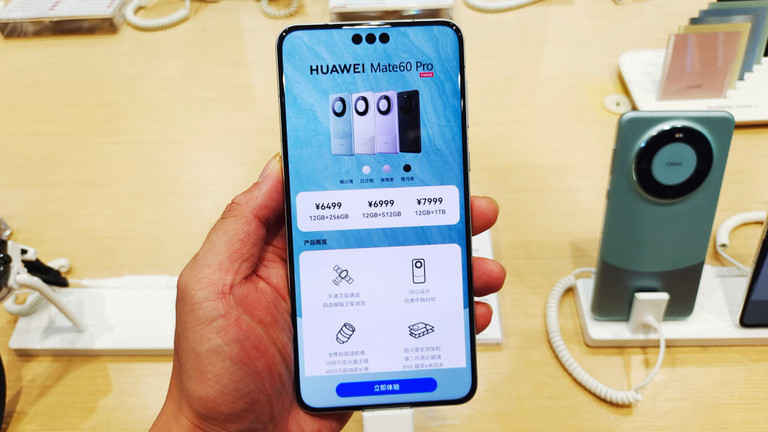
The telecom giant’s new Mate 60 phone is a sign Washington’s chip tech restrictions are not working.
Recently, Huawei’s Mate 60 smartphone rolled out to great acclaim with no advertising campaign or advance notice. On August 30, Reuters reported that the company’s stock rallied due to the surprise drop of the phone with what is being described as unusually high specs, including satellite call capabilities and super-high speeds.
The company, however, has not commented on its technical specifications. It did not specify whether the phone is 5G enabled, though users have confirmed that it is. It merely stated that it had made breakthroughs in satellite communications, which has also been demonstrated. But the major question is about the phone’s chipsets. With a sweeping US sanctions campaign having cut off China’s access to foreign-made chip technology, the US government said it would be looking into the key question: How did China pull this off?
The South China Morning Post, for instance, has grappled with Huawei’s hush-up over the phone’s obviously powerful chipset. One theory is that China’s domestic Semiconductor International Manufacturing Corp (SMIC), which declined to comment, provided the tech. All things being equal, this seems to be the most likely case and a Bloomberg teardown appears to confirm this.
Chinese benchmarking website AnTuTu conducted tests that suggest the central processing unit (CPU) of the Mate 60 could be the domestically-produced Kirin 9000, which “would mark a ‘breakthrough’ for China’s semiconductor industry and a major win for Huawei’s chip smartphone business.”
This appears to be backed up by a Nikkei Asia report from July on Huawei’s re-entry into the 5G phone market, saying that SMIC would be making a seven-nanometer chip for Huawei. This is two generations behind the cutting edge – Apple is about to roll out a new iPhone based on 3nm chips – but still much better than what China should theoretically have access to under American sanctions. Washington’s restrictions on technology access have aimed to arrest Beijing’s chip industry at 14nm levels, or about eight years behind the latest advances.
Another possibility is that Huawei produced the chip with its own supply chain network. A report by Bloomberg, citing the Semiconductor Industry Association, speculates that the telecom firm has been building an independent supply chain network in secret to skirt US export controls by recruiting existing foundries. This would mean that Huawei has finally become independent and beaten US sanctions.
The Mate 60 dropped in the middle of a visit to China by US Secretary of Commerce Gina Raimondo, whose office oversees the implementation of the related sanctions on Beijing’s high-tech industries. The timing of these events would be a major substantive – as well as symbolic – blow to the US, which is trying to unilaterally stifle China’s global competitiveness in sensitive fields. China’s Global Times newspaper picked up on the sentiment of Chinese netizens of “rising up under US pressure.”
Finally, it could be the case that the new phone uses existing inventory from before the US-imposed restrictions, such as chips manufactured by Taiwan Semiconductor Manufacturing Co (TSMC) before September 2020. According to reports, Huawei had been stockpiling chips before the controls came into place and might now be repackaging them with some modifications. If true, this would imply Huawei is still being kept under the thumb of US sanctions. But this is the least likely explanation.
The most likely explanation appears to be that China has either developed the tech to produce advanced chips domestically or found ways to build a supply chain bypassing American sanctions – and either one of them shows a tremendous victory for China’s telecom industry in the face of unfair pressure from the US. In either case, Washington insiders are scared. Just look at the Washington Post’s latest story that the Mate 60 “sparks worry China has found a way around US tech limits,” which quotes American experts as saying that China is still “in the game” when it comes to delivering quality 5G-capable products.
In 2021, Huawei rolled out its in-house HarmonyOS after a US government ban prohibited the firm from doing business with American companies such as Google, forcing Huawei devices to run gutted versions of Android without any Google apps. The company was able to successfully adapt at that time, creating its own operating system in a field that is 99% saturated by Google’s Android and Apple’s iOS. That was no small move and speaks to Chinese ingenuity, as well as the success of China’s reform and opening-up policies in general.
Anyone who values a free and open market should delight in Huawei’s success with the Mate 60 in light of the unprecedented hurdles faced by the company. It would be difficult to call it a rare achievement considering the company’s track record – but it is certainly a very inspiring tale nonetheless.